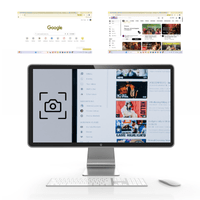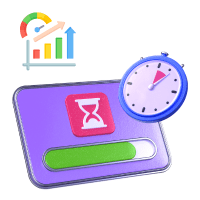
Talking about today’s work world, virtual meetings and work-from-anywhere setups are as common as working from the office 5 or 6 days a week. However, with this kind of communication, we also need meeting guidelines. Establishing a virtual meeting etiquette is key to ensuring that everyone is seen, heard, and engaged. Moreover, most importantly, everyone must be able to participate in meaningful conversations.
Online etiquette of virtual meetings helps your teams increase productivity, provide their best input, and foster strong professional bonds. Today, you will learn our perspective on this, along with some rules, tips, and, of course, etiquette for conducting and attending virtual meetings successfully. With that out of our way, let’s dive right into it.
What is Virtual Meeting Etiquette?
Virtual meetings etiquette is all about how you conduct yourself properly and treat others in virtual meetings. These include all the rules, virtual meeting practices, and ethics, which you must follow to ensure that the conversation goes smoothly. Here are a few more things you need to know.
- Good etiquette for virtual meetings is expected from everyone when connecting with other departments on video calls, leading project start meetings, or brainstorming ideas.
- Your business’s online meeting etiquette ties back to its foundational values, philosophies, and objectives.
- While some aspects can be particular to your industry, some common rules can make a long-lasting and positive impact.
- There are some major differences between in-person and remote meetings, you must account for to stay on track, on time, and informed.
Make Your Meetings More Effective with These 14 Essential Virtual Meeting Etiquette
It may come as a shock. However, you, as an employee, are more entitled to follow the virtual meeting etiquette. On the other hand, your manager or team leader gets more flexibility due to more authority. Moreover, with the hard truth out of the way, here are 14 must-follow staff meeting etiquette rules for team members to conduct themselves during virtual meetings.
1. Know the Virtual Meeting Platform
Let us make it very clear to you. You will not be deciding which platform the meeting will be held on. So, you might be familiar with, for example, Zoom. However, be prepared and flexible to use any virtual meeting software your manager decides on. Overall, you need to be familiar with the controls so that you don’t mess up and miss out on important details during the actual conversation.
2. Hands Off the Keyboard
Simply put, keep your hands anywhere but on the keyboard. A good idea is not to show your hands at all unless you are taking notes or raising them to signal that you wish to ask a question or provide your input. Why? Because you can accidentally press a random key combination and, let’s say, unintentionally exit the meeting.
3. Keep Track of Time
Even as an employee, you need to keep track of how much valuable time you have lost in virtual work meetings. After all, you will be the only one who will have to make up for it to complete your work on time. A strong suggestion is to automatically monitor meeting hours by using the best time tracking software and following these tips.
- Excuse yourself from the meeting if it’s taking too long, if you have crucial work.
- Request to provide meeting breaks or wrap it up if it’s taking too long. The latter is only possible in case the majority of team members have important work to do.
- Ask someone else to take notes for you if you have something more urgent to do.
4. Test Your Internet
One of the useful norms for virtual meetings is to always check that your internet and connection are working before joining a meeting. That’s in case there is a probability that the meeting might not be recorded or that no one takes notes. A wise practice here is to test and verify everything at least 30 minutes to an hour before the meeting.
5. Be on Time
An even better virtual meeting rule to follow here is to join the meeting at least 10-15 minutes before the actual starting time. That’s because meetings can also start early for any reason, such as schedule changes, and you might not get a notification. Plus, it also gives you time to prepare for and feel comfortable during the meeting.
Read Also: Top 5 Inventory Management Software for Small Businesses in 2026
6. Keep the Video On
Keeping your video on for the entire duration of the meeting shows your professionalism. Plus, it also marks your presence, makes you more confident, and ensures that you are noticed and heard. Think of it like an in-person meeting.
7. Mute & Unmute Professionally
A very important virtual meetings etiquette to remember is not to disturb during the meeting. You might not speak out of your turn. However, you might have unmuted during that time, which can lead to the microphone catching other noises, such as your pet’s sound or your child laughing. Similarly, remaining muted while you are speaking can also cause all sorts of awkward situations, and of course, it will waste everyone’s time as well.
8. Have a Clean Background
It’s again a good idea to keep the background as professional as possible. Maybe you want to cover up the wall dirt with pictures, apply the blur filter in case there is something you don’t want to be seen, or put up a virtual background if the meeting software allows that.
9. Focus
Other than to increase workplace productivity, bringing all your attention to the meeting is important. On one hand, it’s for your own good only, as you will ask intelligent questions, get noticed, and even make the meeting more interesting. Conducting yourself like this ensures that everyone is involved and can easily find the simplest solutions to even the most complex problems together.
10. Ask the Agenda
As we mentioned before, you need to come prepared for the remote meeting. One of the best ways to do this is if you know the agenda beforehand. Usually, you will be told this in advance. However, don’t hesitate to ask if it’s otherwise.
11. Dress Professionally
You might be thinking of wearing your pyjamas during the remote meeting. After all, it’s not in-person in the office. However, no, how you dress sends the first impression about your behavior and how you will conduct yourself for the rest of the meeting. Plus, you never know what your manager’s perspective might be on dressing casually during meetings. So, don’t even think about wearing your pyjamas with a shirt.
12. Avoid Distractions
Avoiding distractions leads to increased focus in the meeting. Here are some tips for following this virtual meeting etiquette.
- Put your phone on silent mode, switch it off, or away during the entire conversation.
- Turn off the music or TV. If this is not possible, go to another room for the conversation.
- Close or minimise all other tabs.
- Mute notifications.
13. Speak & Listen
A conversation is all about listening and speaking, with more of the former. This online meeting etiquette involves doing the same. You already know the drill. Don’t speak out of your turn, politely raise your hand when you need to ask something, excuse yourself for causing any inconvenience, etc. Nonetheless, here are a few helpful tips in this regard.
- Speak confidently and concisely.
- Avoid repeating yourself and do not forcefully explain the point.
- Save your questions for the end of the discussion, unless asked to, or excuse yourself if it’s very necessary to ask your question.
14. Minimize Note-Taking
The fewer notes you make during the meeting, the more focused you are. Plus, it is also one of the best ways to show respect. Also, if it’s necessary to jot down points, do it when the leader is not speaking.
Why are Virtual Meeting Guidelines Important?
Simply put, virtual etiquette sets a professional pace for remote discussions and creates powerful working bonds. Here’s why virtual meeting etiquette is important.
- It shows your professionalism, helping build trust and credibility among your colleagues, clients, and shareholders.
- Committing your time, thought, and effort to a meeting before it starts shows your team leaders and potential clients respect. Furthermore, it sets up and guides the conversation, keeping the meetings going smoothly.
- Virtual meetings frequently include attendees from different locations and time zones. Thus, proper virtual meeting guidelines, such as joining early, muting when silent, and staying on topic, decrease distractions and keep the meeting efficient and focused.
- Being mindful of cultural sensitivities fosters an atmosphere of mutual respect and collaboration.
- Proper etiquette ensures effective communication, and everyone can follow through without confusion.
- Finally, it minimizes stress and frustration, especially during back-to-back meetings.
Read Also: How to Calculate Holiday Pay: All You Need to Know About
How to Conduct Yourself During Hybrid Work Meetings?
Another setting where virtual etiquette plays an important role is the hybrid work model. This is where some employees work from anywhere, while others clock in to the office. With that being said, here is a hybrid meeting etiquette guide for new employees and managers.
1. Include Everyone
The first thing to do is leave out neither your in-office nor your remote employees. Include everyone as if they are all in the office.
- Before the meeting’s official start, it’s crucial to include all attendees in a pre-conference chat to make everyone comfortable and set the pace.
- Engage remote employees during the meeting and direct the questions at them if they haven’t given any input in a while.
- After the meeting is done, ensure that the work-from-anywhere members don’t miss the conclusion. To do this, simply call the remote staff right after for a short question-answer session.
2. Stay Heard & Seen
Ensure that everyone is seen and heard. Just like you are including everyone, it’s also a good practice to ensure that you notice, hear, and let everyone speak during their turn. This builds trust, engagement, and even improves employee retention rate, leading to:
- Money saved as you don’t have to hire new employees frequently for the same post.
- Increased productivity and efficiency.
Speaking of increasing productivity, using productivity monitoring and project time tracking software is a better alternative, too.
3. Don’t Whisper
Whispering to another colleague, a friend, or a family member nearby sounds rude and is unprofessional and unethical behavior. So, don’t do it as you will also disturb everyone while doing so, can be left out or made a laughing stock of.
Practical Virtual Meeting Best Practices & Tips You Must Know
Additionally, here are a few more tips for you to properly conduct yourself during online meetings.
- Make eye contact with the camera while speaking.
- Post a signboard or signal to let your family and friends know that you are in a meeting, or just close the door with a do not disturb label.
- Don’t scream if a child or pet jumps into the frame.
- Speak on your turn only.
- Greet everyone
- Practice and test your microphone and audio
- Don’t check your phone, email, or other work.
- Don’t un-mute when you are not speaking or mute when you are. This can only happen if you become used to the virtual meeting platform first.
- Do not leave without notifying everyone else.
Maintain Meetings & Productivity with DeskTrack
Other than virtual etiquette to ensure a smooth conduct and to provide a proper solution to the problem, you also need DeskTrack to maintain productivity without compromising on important points.
- DeskTrack provides you with useful insights that help you identify peak productivity points. All you have to do is take meetings during some other time of the workday.
- DeskTrack helps you identify the ideal meeting duration and properly manage work hours with automatic time tracking.
- It also has the real-time screenshot monitoring feature that can help make meeting presentations. Plus, it also helps you identify if there were any insider threats while you were conducting the important meeting.
Other features, such as project management and a real-time app, URL, and file usage monitoring, streamline workflows and increase efficiency. Try now and realize why 8000+ businesses around the world call it the best employee monitoring software.
Frequently Asked Questions (FAQ)
Q. What is Virtual Meeting Etiquette?
Ans. Virtual meetings etiquette is all about how you conduct yourself properly and treat others in virtual meetings. These include all the rules, virtual meeting norms, and ethics, which you must follow to ensure that the conversation goes smoothly.
Q. What are the Etiquettes Followed in a Virtual Meeting?
Ans. Showing these 14 etiquettes is always good for employees.
- Know the Meeting Platform
- Hands Off the Keyboard
- Keep Track of Time
- Test Your Internet
- Be on Time
- Keep the Video On
- Mute & Unmute Professionally
- Have a Clean Background
- Focus
- Ask the Agenda
- Dress Professionally
- Avoid Distractions
- Speak & Listen
- Minimize Note-Taking
Q. What Should You Do with Your Hands During Virtual Meetings?
Ans. Other than not placing them on the keyboard, not showing hand gestures can be interpreted as being indifferent. So, it’s important to also signal with your hands while you speak.
Q. What are the Do’s and Don’ts in a Virtual Meeting?
Ans. Here’s a comprehensive list.
Do’s
- Make eye contact with the camera while speaking.
- Post a signboard or signal to let your family and friends know that you are in a meeting, or just close the door with a do not disturb label.
- Speak on your turn only.
- Greet everyone
- Practice and test your microphone and audio
Don’ts
- Don’t scream if a child or pet jumps into the frame.
- Don’t check your phone, email, or other work.
- Don’t un-mute when you are not speaking or mute when you are.
- Do not leave without notifying everyone else.
Q. Why is Virtual Meeting Etiquette Important?
Ans. Here’s why virtual meetings etiquette is important.
- It shows your professionalism, helping build trust and credibility among your colleagues, clients, and shareholders.
- Committing your time, thought, and effort to a meeting before it starts shows your team leaders and potential clients respect. Furthermore, it sets up and guides the conversation, keeping the meetings going smoothly.
- Virtual meetings frequently include attendees from different locations and time zones. Thus, proper guidelines, such as joining early, muting when silent, and staying on topic, decrease distractions and keep the meeting efficient and focused.
- Being mindful of cultural sensitivities fosters an atmosphere of mutual respect and collaboration.
- Proper etiquette ensures effective communication, and everyone can follow through without confusion.
- Finally, it minimizes stress and frustration, especially during back-to-back meetings.










